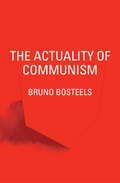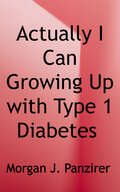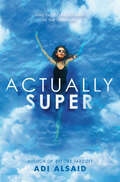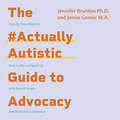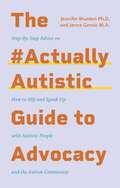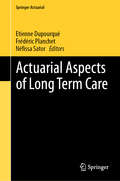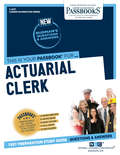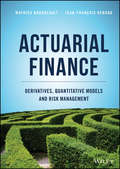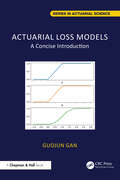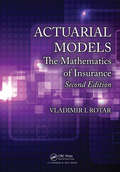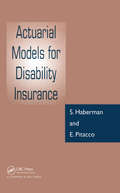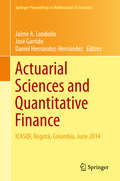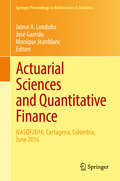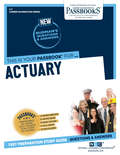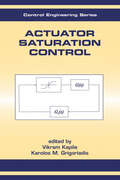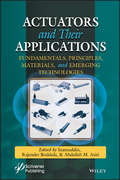- Table View
- List View
The Actuality of Communism
by Bruno BosteelsOne of the rising stars of contemporary critical theory, Bruno Bosteels discusses the new currents of thought generated by figures such as Alain Badiou, Jacques Rancière and Slavoj i ek, who are spearheading the revival of interest in communism. Bosteels examines this resurgence of communist thought through the prism of "speculative leftism" - an incapacity to move beyond lofty abstractions and thoroughly rethink the categories of masses, classes and state. Debating those questions with writers including Roberto Esposito and Alberto Moreiras, Bosteels also provides a vital account of the work of the Bolivian Vice President and thinker Álvaro García Linera.From the Hardcover edition.
Actually, I also Have Plug-ins: Volume 1 (Volume 1 #1)
by Yin Ya[Savage Melting VS Magical False Benevolence]Ezra Continent was a world where magic and martial arts prevailed. After death, they accidentally witnessed the murder scene and were forced to bind to the Child of Fate.Who said that the heart of the child of destiny must be filled with money? The one he met was a black bag, he thought he had found a thick leg, but who knew that this person was not only black-hearted, even the leg he hugged was black, and his conscience was also a passerby.
Actually, I also Have Plug-ins: Volume 2 (Volume 2 #2)
by Yin Ya[Savage Melting VS Magical False Benevolence]Ezra Continent was a world where magic and martial arts prevailed. After death, they accidentally witnessed the murder scene and were forced to bind to the Child of Fate.Who said that the heart of the child of destiny must be filled with money? The one he met was a black bag, he thought he had found a thick leg, but who knew that this person was not only black-hearted, even the leg he hugged was black, and his conscience was also a passerby.
Actually, I also Have Plug-ins: Volume 3 (Volume 3 #3)
by Yin Ya[Savage Melting VS Magical False Benevolence]Ezra Continent was a world where magic and martial arts prevailed. After death, they accidentally witnessed the murder scene and were forced to bind to the Child of Fate.Who said that the heart of the child of destiny must be filled with money? The one he met was a black bag, he thought he had found a thick leg, but who knew that this person was not only black-hearted, even the leg he hugged was black, and his conscience was also a passerby.
Actually, I also Have Plug-ins: Volume 4 (Volume 4 #4)
by Yin Ya[Savage Melting VS Magical False Benevolence]Ezra Continent was a world where magic and martial arts prevailed. After death, they accidentally witnessed the murder scene and were forced to bind to the Child of Fate.Who said that the heart of the child of destiny must be filled with money? The one he met was a black bag, he thought he had found a thick leg, but who knew that this person was not only black-hearted, even the leg he hugged was black, and his conscience was also a passerby.
Actually, I Can: Growing Up with Type 1 Diabetes, a Story of Unexpected Empowerment
by Morgan J. PanzirerMorgan was diagnosed with Type 1 Diabetes at 6 years old -- but that didn't stop her! In this informative memoir, she looks back at her life and shares her experiences to help others who've been diagnosed, and their families, to understand everything from the gadgets to the legislation, the joy and the frustrations. Morgan has dedicated her life to the advocacy and education of her disease.
Actually Super
by Adi AlsaidA globetrotting novel that takes a determined teen from Japan to Australia and to Argentina and Mexico on a quest to prove that humanity is more good than bad from the author of Let&’s Get Lost and Before Takeoff.Isabel is having an existential crisis. She&’s three years into high school, and everything she&’s learned has only shaken her faith in humanity. Late one night, she finds herself drawn to a niche corner of the internet—a forum whose members believe firmly in one thing: that there are indeed people out in the world quietly performing impossible acts of heroism. You might even call them supers. No, not in the comic book sense—these are real people, just like each of us, but who happen to have a power or two. If Isabel can find them, she reasons, she might be able to prove to herself that humanity is more good than bad.So, the day she turns 18, she sets off on a journey that will take her from Japan to Australia, and from Argentina to Mexico, with many stops along the way. She longs to prove one—just one—super exists to restore her hope for the future.Will she find what she&’s looking for? And how will she know when—if—she does?
The #ActuallyAutistic Guide to Advocacy: Step-by-Step Advice on How to Ally and Speak Up with Autistic People and the Autism Community
by Jenna Gensic Jennifer BruntonThe #ActuallyAutistic Guide to Advocacy takes an in-depth look at the key elements of effective, respectful, inclusive advocacy and allyship. Every topic was chosen, shaped, and informed by #ActuallyAutistic perspectives.The step-by-step guide discusses various aspects of how autism is perceived, explores how best to speak up for individual needs, and introduces advocacy for the wider autistic community. Each step outlines one vital aspect of advocacy and allyship, such as emphasizing acceptance, avoiding assumptions and assuming competence. The advice and strategies laid out in this guide center the wisdom and experiences of Autistic people and enable the listener to confidently speak up with insight and understanding.(P) 2022 Jessica Kinglsey Publishers
The #ActuallyAutistic Guide to Advocacy: Step-by-Step Advice on How to Ally and Speak Up with Autistic People and the Autism Community
by Jenna Gensic Jennifer BruntonThe #ActuallyAutistic Guide to Advocacy takes an in-depth look at the key elements of effective, respectful, inclusive advocacy and allyship. Every topic was chosen, shaped, and informed by #ActuallyAutistic perspectives. The step-by-step guide discusses various aspects of how autism is perceived, explores how best to speak up for individual needs, and introduces advocacy for the wider autistic community. Each step outlines one vital aspect of advocacy and allyship, such as emphasizing acceptance, avoiding assumptions and assuming competence. The advice and strategies laid out in this guide center the wisdom and experiences of Autistic people and enable the reader to confidently speak up with insight and understanding.
Actuarial Aspects of Long Term Care (Springer Actuarial)
by Frédéric Planchet Etienne Dupourqué Néfissa SatorThis book proposes a review of Long-Term Care insurance; this issue is addressed both from a global point of view (through a presentation of the risk of dependence associated with the aging of the population) and an actuarial point of view (with the presentation of existing insurance products and actuarial techniques for pricing and reserving). It proposes a cross-view of American and European experiences for this risk. This book is the first dedicated entirely to long-term care insurance and aims to provide a useful reference for all actuaries facing this issue. It is intended for both professionals and academics.
Actuarial Clerk: Passbooks Study Guide (Career Examination Series #C-2417)
by National Learning CorporationThe Actuarial Clerk Passbook® prepares you for your test by allowing you to take practice exams in the subjects you need to study. It provides hundreds of questions and answers in the areas that will likely be covered on your upcoming exam, including but not limited to: algebraic reasoning; understanding information presented in tables; basic actuarial reasoning; and other related areas.
Actuarial Finance: Derivatives, Quantitative Models and Risk Management
by Mathieu Boudreault Jean-François RenaudA new textbook offering a comprehensive introduction to models and techniques for the emerging field of actuarial Finance Drs. Boudreault and Renaud answer the need for a clear, application-oriented guide to the growing field of actuarial finance with this volume, which focuses on the mathematical models and techniques used in actuarial finance for the pricing and hedging of actuarial liabilities exposed to financial markets and other contingencies. With roots in modern financial mathematics, actuarial finance presents unique challenges due to the long-term nature of insurance liabilities, the presence of mortality or other contingencies and the structure and regulations of the insurance and pension markets. Motivated, designed and written for and by actuaries, this book puts actuarial applications at the forefront in addition to balancing mathematics and finance at an adequate level to actuarial undergraduates. While the classical theory of financial mathematics is discussed, the authors provide a thorough grounding in such crucial topics as recognizing embedded options in actuarial liabilities, adequately quantifying and pricing liabilities, and using derivatives and other assets to manage actuarial and financial risks. Actuarial applications are emphasized and illustrated with about 300 examples and 200 exercises. The book also comprises end-of-chapter point-form summaries to help the reader review the most important concepts. Additional topics and features include: Compares pricing in insurance and financial markets Discusses event-triggered derivatives such as weather, catastrophe and longevity derivatives and how they can be used for risk management; Introduces equity-linked insurance and annuities (EIAs, VAs), relates them to common derivatives and how to manage mortality for these products Introduces pricing and replication in incomplete markets and analyze the impact of market incompleteness on insurance and risk management; Presents immunization techniques alongside Greeks-based hedging; Covers in detail how to delta-gamma/rho/vega hedge a liability and how to rebalance periodically a hedging portfolio. This text will prove itself a firm foundation for undergraduate courses in financial mathematics or economics, actuarial mathematics or derivative markets. It is also highly applicable to current and future actuaries preparing for the exams or actuary professionals looking for a valuable addition to their reference shelf. As of 2019, the book covers significant parts of the Society of Actuaries’ Exams FM, IFM and QFI Core, and the Casualty Actuarial Society’s Exams 2 and 3F. It is assumed the reader has basic skills in calculus (differentiation and integration of functions), probability (at the level of the Society of Actuaries’ Exam P), interest theory (time value of money) and, ideally, a basic understanding of elementary stochastic processes such as random walks.
Actuarial Loss Models: A Concise Introduction (Chapman & Hall/CRC Series in Actuarial Science)
by Guojun GanActuarial loss models are statistical models used by insurance companies to estimate the frequency and severity of future losses, set premiums, and reserve funds to cover potential claims. Actuarial loss models are a subject in actuarial mathematics that focus on the pricing and reserving for short-term coverages.This is a concise textbook written for undergraduate students majoring in actuarial science who wish to learn the basics of actuarial loss models. This book can be used as a textbook for a one-semester course on actuarial loss models. The prerequisite for this book is a first course on calculus. The reader is supposed to be familiar with differentiation and integration.This book covers part of the learning outcomes of the Fundamentals of Actuarial Mathematics (FAM) exam and the Advanced Short-Term Actuarial Mathematics (ASTAM) exam administered by the Society of Actuaries. It can be used by actuarial students and practitioners who prepare for the aforementioned actuarial exams.Key Features: Review core concepts in probability theory. Cover important topics in actuarial loss models. Include worked examples. Provide both theoretical and numerical exercises. Include solutions of selected exercises.
Actuarial Models: The Mathematics of Insurance, Second Edition
by Vladimir I. RotarActuarial Models: The Mathematics of Insurance, Second Edition thoroughly covers the basic models of insurance processes. It also presents the mathematical frameworks and methods used in actuarial modeling. This second edition provides an even smoother, more robust account of the main ideas and models, preparing students to take exams of the Societ
Actuarial Models for Disability Insurance
by S Haberman E PitaccoDisability insurance, long-term care insurance, and critical illness cover are becoming increasingly important in developed countries as the problems of demographic aging come to the fore. The private sector insurance industry is providing solutions to problems resulting from these pressures and other demands of better educated and more prosperous
Actuarial Sciences and Quantitative Finance: ICASQF, Bogotá, Colombia, June 2014 (Springer Proceedings in Mathematics & Statistics #135)
by Daniel Hernández-Hernández Jaime A. Londoño José GarridoFeaturing contributions from industry and academia, this volume includes chapters covering a diverse range of theoretical and empirical aspects of actuarial science and quantitative finance, including portfolio management, derivative valuation, risk theory and the economics of insurance. Developed from the First International Congress on Actuarial Science and Quantitative Finance, held at the Universidad Nacional de Colombia in Bogotá in June 2014, this volume highlights different approaches to issues arising from industries in the Andean and Carribean regions. Contributions address topics such as Reverse mortgage schemes and urban dynamics, modeling spot price dynamics in the electricity market, and optimizing calibration and pricing with SABR models.
Actuarial Sciences and Quantitative Finance: ICASQF2016, Cartagena, Colombia, June 2016 (Springer Proceedings in Mathematics & Statistics #214)
by Jaime A. Londoño José Garrido Monique JeanblancDeveloped from the Second International Congress on Actuarial Science and Quantitative Finance, this volume showcases the latest progress in all theoretical and empirical aspects of actuarial science and quantitative finance. Held at the Universidad de Cartagena in Cartegena, Colombia in June 2016, the conference emphasized relations between industry and academia and provided a platform for practitioners to discuss problems arising from the financial and insurance industries in the Andean and Caribbean regions. Based on invited lectures as well as carefully selected papers, these proceedings address topics such as statistical techniques in finance and actuarial science, portfolio management, risk theory, derivative valuation and economics of insurance.
Actuary: Passbooks Study Guide (Career Examination Series #C-7)
by National Learning CorporationThe Actuary Passbook® prepares you for your test by allowing you to take practice exams in the subjects you need to study. It provides hundreds of questions and answers in the areas that will likely be covered on your upcoming exam, including but not limited to: general mathematics; specialized actuarial mathematics; all phases of the insurance business; understanding and interpreting written material; and other related areas.
Actuator Saturation Control (Automation and Control Engineering)
by Vikram Kapila Karolos M. GrigoriadisCompiling the most significant advances from nearly a decade of research, this reference compares and evaluates a wide variety of techniques for the design, analysis, and implementation of control methodologies for systems with actuator saturation. The book presents efficient computational algorithms and new control paradigms for application in the
Actuators and Their Applications: Fundamentals, Principles, Materials, and Emerging Technologies (Materials Research Foundations Ser.)
by Rajender Boddula Inamuddin Abdullah M. AsiriAs demand has increased for new types of equipment that are more suited to the ever-evolving world of industry, demand for both new and traditional types of actuators has soared. From automotive and aeronautical to biomedical and robotics, engineers are constantly developing actuating devices that are adapted to their particular needs in their particular field, and actuators are used in almost every field of engineering that there is. This volume not only lays out the fundamentals of actuators, such as how they operate, the different kinds, and their various applications, but it also informs the engineer or student about the new actuators that are being developed and the state-of-the-art of actuators. Edited and written by highly experienced and well-respected engineers with a deep understanding of their subject, there is no other volume on actuators that is more current or comprehensive. Whether as a guide for the latest innovations in actuators, a refresher reference work for the veteran engineer, or an introductory text for the engineering student, this is a must-have for any engineer’s or university’s library. Covering the theory and the practical applications, this breakthrough volume is a “one stop shop” for any engineer or student interested in actuators.
Acumen and Lean Data 2018
by V. Kasturi Rangan Shawn Cole Caitlin Lindsay Reimers Brumme Alnoor EbrahimCase
Acumen Fund: Measurement in Impact Investing (A)
by Alnoor Ebrahim V. Kasturi RanganAcumen Fund is a global venture capital firm with a dual purpose: it looks for a return on its investments, and it also seeks entrepreneurial solutions to global poverty. This case examines Acumen's new projects in Kenya. The organization's investment committee and its chief investment officer, Brian Trelstad, must decide whether or not to fund two for-profit ventures. The first provides clean and accessible shower and toilet facilities in urban areas, serving a critical need for low-income populations - its financial sustainability, however, is less clear. The second investment is a network of successful private health clinics that primarily serve middle-income populations but which have the potential to reach low-income markets. On what basis should Acumen decide whether or not to invest? What performance metrics should it use? As the investment committee nears a decision, political and social unrest breaks out in Kenya following a highly contested presidential election. Acumen Fund must now also consider the political risks of investing.
Acumen Fund: Measurement in Impact Investing (B)
by Alnoor Ebrahim V. Kasturi RanganAs Acumen Fund, a global venture philanthropy firm, moves forward with an investment portfolio exceeding $22 million, it runs into two critical measurement problems. First, how should it track the performance of each investment when its interest is not just the bottom line, but also social impact? What should its performance tracking system look like to enable ease of comparison, and to identify problems before they become too significant to fix? The second challenge involves attracting investors. Acumen wants to build the field of "social investing" by creating a new asset class for investors who care about social impact. Doing so will require working with competitors in the field in order to establish benchmarks and standards of measurement. How can Acumen build industry-wide benchmarks when peer organizations are concerned about confidentiality of data? Without such comparisons, how will Acumen attract investors to the field?
